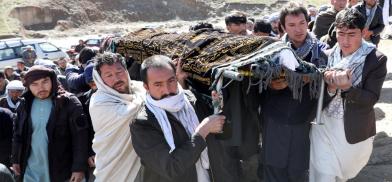Leaving Afghanistan's fate to the Taliban
It would not be surprising if American troops are also attacked after part withdrawal has taken place, with blame, apportioned to Islamic State, as was done in the case of the recent attack on Kabul gurdwara, while China and Pakistan laughed all the way home, writes Lt Gen P. C. Katoch (retd) for South Asia Monitor

US Secretary of State Mike Pompeo’s visit to Afghanistan on March 23 must have given him plenty of satisfaction in pushing the US-Taliban deal forward but his happiness appears to be short-lived. The prisoner swap was to commence on March 31 and the Afghan Government announced a 21-member team (five being women) for talks with the Taliban on March 27. This team announced by the Ministry of Peace is headed by Masoom Stanekzai, former head of the National Directorate of Security, with politicians, former officials and representatives of civil societies. The development was endorsed by the US Special Envoy Zalmay Khalilzad.
While congratulating Afghan political and civil society leaders, he said, “They’ve forged an inclusive negotiating team for talks with the Taliban...This consensus is a meaningful step that moves the parties significantly closer to intra-Afghan negotiations.”
But the offer was trashed by the Taliban two days later (March 29) with their spokesman Zabihullah Mujahid saying that Taliban will not negotiate with the 21-member team as it was not selected in a way that included “all Afghan factions”, without elaborating who had been left out.
During his visit on March 23, Pompeo had threatened to cut off $1 billion US aid to Afghanistan this year if President Ashraf Ghani and CEO Abdullah Abdullah who has also declared himself President doesn’t resolve mutual differences over the election results.
He also said that aid could also be similarly cut next year also if the US-Taliban deal was not allowed to progress. The latter obviously implied the prisoner swap of 5,000 ANSF and 1,000 ANSF that the US had agreed with the Taliban without reference or concurrence of the Afghan government.
President Ghani was amenable to a 1,500 swap from both sides, but it was not acceptable to the Taliban. Following Pompeo’s threat, news of March 26 reported that the Afghan Government and the Taliban agreed to start swapping prisoners on March 31 after technical teams from both sides held a video conference in the presence of Qatar, US and Red Cross representatives.
The decision was that the Taliban would send a verification team to Bagram prison for identification, confirmation, and release of prisoners. Afghanistan’s National Security Council (NSC) stated, “To carry out further discussions, a Taliban team will meet with the government face to face in Afghanistan in the coming days.” A second meeting through video conferencing also took place.
It is not known whether the prisoner swap has physically commenced but on March 31 a three-member Taliban team reportedly arrived in Kabul to begin the prisoner exchange process, even as Kabul was locked down due to the Wuhan Virus hitting the country.
On March 26, the Afghanistan government announced the release of up to 10,000 prisoners (mostly women, juveniles and sick) to slow the virus spread. Kabul has been locked down due to the pandemic. The country has a major problem with tens of thousands of Afghans returning from Iran which is hit hard by the virus and has had to release 85,000 prisoners. Ten Afghan refugees have died in Iran due to the Wuhan Virus. Afghanistan has so far reported only four Wuhan Virus deaths and 192 infected cases but actual figures may be far more considering the availability of healthcare facilities, lack of mass testing and medical equipment, because of which many deaths due to the virus may not be reported.
There can be many reasons why the Taliban is stonewalling talks with the Afghan government. They may be viewing those nominated in the 21-member team loyal to Afghan president. But a bigger reason could be sticking to their original demand that unless all the 5,000 prisoners are released according to the US-Taliban deal, they will not participate in the Intra-Afghan talks. This they had already stated in not so many words earlier.
A third reason could be Taliban playing cat and mouse game with the US, enjoying what is happening as latter’s mainland has been hit severely by the Wuhan virus, with many homeless living in parks and on the roads with shelters shut-in Las Vegas, and the captain of USS Theodore Roosevelt in Western Pacific appealing for help as the aircraft the carrier has been hit by the virus. As it is the Taliban has a free hand in attacking at will as long as US troops are spared. It would not be surprising if American troops are also attacked after part withdrawal has taken place, with blame, apportioned to Islamic State, as was done in the case of the recent attack on Kabul gurdwara, while China and Pakistan laughed all the way home.
The US is already resigned to leave Afghanistan’s fate largely to the Taliban. Robert Kaplan wrote in his book ‘The Revenge of Geography’, “An Afghanistan that falls to Taliban sway threatens to create a succession of radicalized Islamic societies from the Indian-Pakistani border to Central Asia. This in effect would be a Greater Pakistan, giving Pakistan’s Inter-Services Intelligence Directorate the ability to create a clandestine empire composed of the likes of Jalaluddin Haqqani, Gulbuddin Hekmatyar, and the Lashkar-e-Taiba; able to confront India in the manner that Hezbollah and Hamas confront Israel”.
But it will be naïve for the US to believe that mainland US and its assets abroad will be spared. Taliban are fully backed by China-Pakistan while Russia and Iran also have made peace with Taliban.
(The author is an Indian Army veteran)









Post a Comment